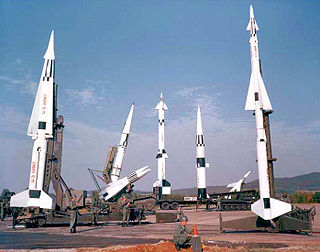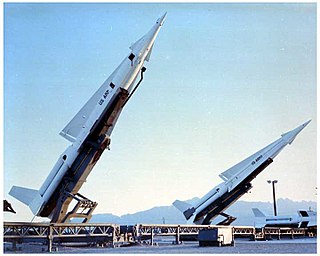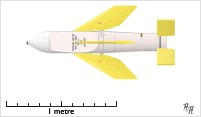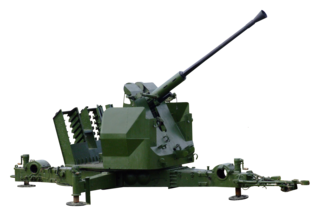
Rapier is a surface-to-air missile developed for the British Army to replace their towed Bofors 40/L70 anti-aircraft guns. The system is unusual as it uses a manual optical guidance system, sending guidance commands to the missile in flight over a radio link. This results in a high level of accuracy, therefore a large warhead is not required.

Anti-aircraft warfare is the counter to aerial warfare and includes "all measures designed to nullify or reduce the effectiveness of hostile air action". It encompasses surface-based, subsurface (submarine-launched), and air-based weapon systems, in addition to associated sensor systems, command and control arrangements, and passive measures. It may be used to protect naval, ground, and air forces in any location. However, for most countries, the main effort has tended to be homeland defence. Missile defence is an extension of air defence, as are initiatives to adapt air defence to the task of intercepting any projectile in flight.

Project Nike was a U.S. Army project, proposed in May 1945 by Bell Laboratories, to develop a line-of-sight anti-aircraft missile system. The project delivered the United States' first operational anti-aircraft missile system, the Nike Ajax, in 1953. A great number of the technologies and rocket systems used for developing the Nike Ajax were re-used for a number of functions, many of which were given the "Nike" name . The missile's first-stage solid rocket booster became the basis for many types of rocket including the Nike Hercules missile and NASA's Nike Smoke rocket, used for upper-atmosphere research.

The Nike Hercules, initially designated SAM-A-25 and later MIM-14, was a surface-to-air missile (SAM) used by U.S. and NATO armed forces for medium- and high-altitude long-range air defense. It was normally armed with the W31 nuclear warhead, but could also be fitted with a conventional warhead for export use. Its warhead also allowed it to be used in a secondary surface-to-surface role, and the system also demonstrated its ability to hit other short-range missiles in flight.

The RIM-7 Sea Sparrow is a U.S. ship-borne short-range anti-aircraft and anti-missile weapon system, primarily intended for defense against anti-ship missiles. The system was developed in the early 1960s from the AIM-7 Sparrow air-to-air missile as a lightweight "point-defense" weapon that could be retrofitted to existing ships as quickly as possible, often in place of existing gun-based anti-aircraft weapons. In this incarnation, it was a very simple system guided by a manually aimed radar illuminator.

Seacat was a British short-range surface-to-air missile system intended to replace the ubiquitous Bofors 40 mm gun aboard warships of all sizes. It was the world's first operational shipboard point-defence missile system, and was designed so that the Bofors guns could be replaced with minimum modification to the recipient vessel and (originally) using existing fire-control systems. A mobile land-based version of the system was known as Tigercat.

A fire-control system (FCS) is a number of components working together, usually a gun data computer, a director and radar, which is designed to assist a ranged weapon system to target, track, and hit a target. It performs the same task as a human gunner firing a weapon, but attempts to do so faster and more accurately.

The Type 81 surface-to-air missile (81式短距離地対空誘導弾) or Tan-SAM (短SAM) is a Japanese developed surface-to-air missile currently in service with the Japan Ground Self-Defense Force.

The M247 Sergeant York DIVAD was a self-propelled anti-aircraft gun (SPAAG), developed by Ford Aerospace in the late 1970s. Based on the M48 Patton tank, it replaced the Patton's turret with a new one that featured twin radar-directed Bofors 40 mm rapid-fire guns. The vehicle was named after Sergeant Alvin York, a famous World War I hero.

The English Electric Thunderbird was a British surface-to-air missile produced for the British Army. Thunderbird was primarily intended to attack higher altitude targets at ranges up to approximately 30 miles (48 km), providing wide-area air defence for the Army in the field. Anti-aircraft guns were still used for lower altitude threats. Thunderbird entered service in 1959 and underwent a major mid-life upgrade to Thunderbird 2 in 1966, before being slowly phased out by 1977. Ex-Army Thunderbirds were also operated by the Royal Saudi Air Force after 1967.

Short range air defense (SHORAD) is a group of anti-aircraft weapons and tactics that have to do with defense against low-altitude air threats, primarily helicopters and low-flying aircraft such as the A-10 or Sukhoi Su-25. SHORAD and its complements, HIMAD and THAAD divide air defense of the battlespace into domes of responsibility based on altitude and defensive weapon ranges.

AZP S-60 is a Soviet towed, road-transportable, short- to medium-range, single-barrel anti-aircraft gun from the 1950s. The gun was extensively used in Warsaw Pact, Middle Eastern and Southeast Asian countries.

A director, also called an auxiliary predictor, is a mechanical or electronic computer that continuously calculates trigonometric firing solutions for use against a moving target, and transmits targeting data to direct the weapon firing crew.

United States Army air defense relies on a range of ground launched missiles, ranging from hand held to vehicle mounted systems. The Air Defense Artillery is the branch that specializes in anti-aircraft weapons. In the US Army, these groups are composed of mainly air defense systems such as the PATRIOT Missile System, Terminal High Altitude Air Defense, and the Avenger Air Defense system which fires the FIM-92 Stinger missile.

The Type 03 Medium-Range Surface-to-Air Missile or SAM-4 or Chu-SAM is a Japanese developed surface-to-air missile system currently in service with the JGSDF. The SAM's vehicle chassis is based on the Kato Works Ltd/Mitsubishi Heavy Industries NK series heavy crane truck. It uses a state-of-the-art active electronically scanned array radar.

Raco Army Airfield is a closed military airfield. It is located 24.5 miles (39.4 km) west-southwest of Sault Ste. Marie, Michigan, United States. It was closed in 1972.
The Western Electric M-33 Antiaircraft Fire Control System was an X-Band "Gunfire Control Radar", for aiming antiaircraft artillery by computer control. Developed for mobility via 3 trailers, the "M-33 system could compute, for the 90-mm. and 120-mm. guns, firing data for targets with speeds up to 1,000 mph", and for targets at 120,000 yards had similar gun laying accuracy as "SCR-584 type radars" at 70,000 yards. The system included a telescopic "target selector" on a tripod near the guns for additional measurement of aircraft "azimuth and elevation data [to] be transmitted to the computer and utilized as gun directing data."

The Nike Ajax was an American guided surface-to-air missile (SAM) developed by Bell Labs for the United States Army. The world's first operational guided surface-to-air missile, the Nike Ajax was designed to attack conventional bomber aircraft flying at high subsonic speeds and altitudes above 50,000 feet (15 km). Nike entered service in 1954 and was initially deployed within the United States to defend against Soviet bomber attacks, though it was later deployed overseas to protect US military bases, and was also sold to various allied militaries. Some examples remained in use until the 1970s.
Army Air Defense Command, previously Army Anti-Aircraft Command, was a major command of the United States Army which existed from 1957 to 1974. The previous ARAACOM was created in 1950 and was redesignated ARADCOM in 1957. It was formed to command the Army units allocated to the air defense of the Continental United States. ARAACOM was also charged with becoming the Army component of a joint continental defense force, if and when the joint force was designated.

The Bofors 40 mm Automatic Gun L/70,, is a multi-purpose autocannon developed by the Swedish arms manufacturer AB Bofors during the second half of the 1940s as a modern replacement for their extremely successful World War II-era Bofors 40 mm L/60 gun-design. It was initially intended as a dedicated anti-aircraft weapon, being sold as Bofors 40 mm Automatic A.A. Gun L/70, but has since its conception been redeveloped into a dedicated multi-purpose weapon capable of firing both sabot projectiles and programmable ammunition. The Bofors 40 mm L/70 design never achieved the same popularity and historical status as the original L/60 design but has still seen great export and popularity to this day, having been adopted by around 40 different nations and even being accepted as NATO-standard in November 1953. It is still being produced and sold, and several variants exist for both field and naval applications. A notable variant is the Bofors 40/70B "light armored vehicle variant" which is in use on the Swedish Strf 9040 and Korean K21 infantry fighting vehicles.



















